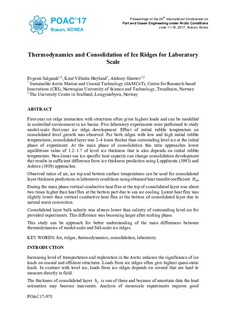| dc.contributor.author | Salganik, Evgenii | |
| dc.contributor.author | Høyland, Knut Vilhelm | |
| dc.contributor.author | Shestov, Aleksey | |
| dc.date.accessioned | 2018-03-22T12:54:57Z | |
| dc.date.available | 2018-03-22T12:54:57Z | |
| dc.date.created | 2017-08-11T12:06:50Z | |
| dc.date.issued | 2017 | |
| dc.identifier.issn | 0376-6756 | |
| dc.identifier.uri | http://hdl.handle.net/11250/2491738 | |
| dc.description.abstract | First-year ice ridge interaction with structures often gives highest loads and can be modelled in controlled environment in ice basins. Five laboratory experiments were performed to study model-scale first-year ice ridge development. Effect of initial rubble temperature on consolidated level growth was observed. For both ridges with low and high initial rubble temperatures, consolidated layer was 2–4 times thicker than surrounding level ice at the initial phase of experiment. At the main phase of consolidation this ratio approaches lower equilibrium value of 1.2–1.7 of level ice thickness that is also depends on initial rubble temperature. Non-linear sea ice specific heat capacity can change consolidation development that results in sufficient difference from ice thickness prediction using Leppäranta (1993) and Ashton (1989) approaches. Observed ratios of air, ice top and bottom surface temperatures can be used for consolidated layer thickness predictions in laboratory conditions using obtained heat transfer coefficient Hia. During the main phase vertical conductive heat flux at the top of consolidated layer was about two times higher than heat flux at the bottom part due to sea ice cooling. Latent heat flux was slightly lower than vertical conductive heat flux at the bottom of consolidated layer due to natural water convection. Consolidated layer bulk salinity was always lower than salinity of surrounding level ice for provided experiments. This difference was becoming larger after melting phase. This study can be approach for better understanding of the main differences between thermodynamics of model-scale and full-scale ice ridges. | nb_NO |
| dc.language.iso | eng | nb_NO |
| dc.publisher | Port and Ocean Engineering under Arctic Conditions, POAC | nb_NO |
| dc.title | Thermodynamics and Consolidation of Ice Ridges for Laboratory Scale | nb_NO |
| dc.type | Journal article | nb_NO |
| dc.type | Peer reviewed | nb_NO |
| dc.description.version | publishedVersion | nb_NO |
| dc.source.journal | Proceedings - International Conference on Port and Ocean Engineering under Arctic Conditions | nb_NO |
| dc.identifier.cristin | 1485741 | |
| dc.description.localcode | © 2017 Port and Ocean Engineering under Arctic Conditions. Available at http://www.poac.com/Papers/2017/author_index.htm | nb_NO |
| cristin.unitcode | 194,64,91,0 | |
| cristin.unitname | Institutt for bygg- og miljøteknikk | |
| cristin.ispublished | true | |
| cristin.fulltext | original | |
| cristin.qualitycode | 1 | |
